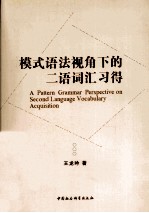

模式语法视角下的二语词汇习得 英文版PDF格式文档图书下载
- 购买点数:9 点
- 作 者:王龙吟著
- 出 版 社:北京:中国社会科学出版社
- 出版年份:2011
- ISBN:9787516103166
- 标注页数:173 页
- PDF页数:192 页
Chapter 1 Introduction 1
1.1 Research orientation 1
1.2 Pattern:the object of research 1
1.3 Rationale 3
1.4 Key research questions 6
1.5 Organization of the book 7
Chapter 2 Pattern Grammar 9
2.1 Identification,definition,and presentation of"pattern" 9
2.2 A historical review of pattern grammar 11
2.2.1 Earlier work on patterns and usage 11
2.2.2 Research on word combinations 12
2.2.3 Lexical grammar 14
2.2.4 Pattern grammar 18
2.3 Two approaches to pattern grammar 21
2.3.1 Approach 1:A word and its patterns 21
2.3.2 Approach 2:A pattern and its words 22
2.4 Pattern-meaning association(PMA):core of pattern grammar 23
2.5 Summary 26
Chapter 3 Pattern Grammar and L2 Vocabulary Development 28
3.1 Pattern and depth of word knowledge 28
3.1.1 Depth of word knowledge 29
3.1.2 Associating pattern with depth of word knowledge 31
3.2 Depth of word knowledge and L2 vocabulary development 33
3.2.1 A unified account of dimensions of L2 vocabulary development research 33
3.2.2 Previous research on depth of L2 vocabulary development 38
3.3 Summary 41
Chapter 4 On the Corpus Method 42
4.1 Justifications for using learner corpora in SLA study 42
4.2 Advantages of using learner corpora in the present research 45
4.2.1 Learner corpora provide large quantities of natural language use data 45
4.2.2 Learner corpora provide a new text type for observation 47
4.3 Nature of corpus linguistics 50
4.3.1 Corpus linguistics is"a new way of thinking about language" 50
4.3.2 Corpora serve both as a test bed and as a source for hypotheses in SLA study 53
4.4 Limitations of using learner corpora in SLA study 54
4.5 Summary 55
Chapter 5 Methodology 57
5.1 Database 57
5.1.1 Preparing the learner corpus 58
5.1.2 Guaranteeing the comparability between different samples of the learner corpus 60
5.1.3 Preparing the control corpus 63
5.1.4 Guaranteeing the comparability between the control corpus and the learner corpus 64
5.2 Reseatch Tools 65
5.2.1 Wmatrix and CLAWS 66
5.2.2 Word Smith Tools 67
5.3 Analytical framework of the present research 68
5.4 Study 1:A word and its patterns—WAY 71
5.4.1 Selecting the research target 71
5.4.2 Research procedure 73
5.5 Study 2:A pattern and its words—V n1 to n2 77
5.5.1 Selecting the research target 78
5.5.2 Research procedure 81
5.6 Study 3:A simpler pattern and its words—V to n 87
5.6.1 Selecting the research target 87
5.6.2 Research procedure 89
5.7 Summary 90
Chapter 6 Results and Discussion 92
6.1 WAY and its patterns 93
6.1.1 PMA as sense-pattern correspondence 93
6.1.2 Effect of pattern complexity on PMA 96
6.1.3 Effect of length of learning experience on PMA 97
6.1.4 Summary of results relating to WAY 98
6.2 "V n1 to n2"and its words 99
6.2.1 PMA as meaning sharedness among words 99
6.2.2 Effect of length of learning experience on PMA 106
6.2.3 Summary of results relating to"V n1 to n2" 108
6.3 "V to n"and its words 108
6.3.1 Effect of pattern complexity on PMA concerning focal words 109
6.3.2 Effect of pattern complexity on PMA concerning non-focal words 110
6.3.3 Summary of results relating to"V to n" 113
6.4 Summary 113
Chapter 7 General Discussion 116
7.1 Interpreting L2 productive vocabulary development on Dimension 1—a word and its patterns 117
7.1.1 Reflections on PMA as sense-pattern correspondence 117
7.1.2 Reflections on effect of pattern complexity on PMA 119
7.1.3 Reflections on effect of length of learning experience on PMA 121
7.1.4 Summary of inferences on Dimension 1 121
7.2 Interpreting L2 productive vocabulary development on Dimension 2—a pattern and its words 122
7.2.1 Reflections on PMA as meaning sharedness among words 122
7.2.2 Reflections on effect of pattern complexity on PMA 127
7.2.3 Reflections on effect of length of learning experience on PMA 128
7.2.4 Summary of inferences on Dimension 2 129
7.3 Summary 129
Chapter 8 Conclusion 131
8.1 A recapitulation of the major findings 131
8.2 Implications 132
8.2.1 Implications for research into English patterns 132
8.2.2 Implications for research into depth of L2 vocabulary development 133
8.2.3 Implications for pedagogy 134
8.3 Limitations of the current research 136
8.4 Suggestions for future research 137
Appendices 138
References 164
- 《模式语法视角下的二语词汇习得 英文版》王龙吟著 2011
- 《基于使用理论视角下的二语词汇搭配习得研究》高维著 2016
- 《视听双重输入模式下的二语词汇习得研究》范烨著 2016
- 《中国学习者二语词汇习得研究 从认知心理的视角》陈万会著 2008
- 《二语词汇宏微观双向教学对比研究》蒋国武,郑通涛著 2016
- 《基于使用理论视角下的二语词汇搭配习得研究=A USAGE-BASED APPROACH TO SECOND LANGUAGE ACQUISITION OF COLLOCATIONS》高维著 2016
- 《语法隐喻理论研究 英文本》范文芳著 2001
- 《汉语语法指南英文版》朱春耕,高燕著 2013
- 《功能语法入门 第2版 英文版》汤普森(Thompson.G.)著 2008
- 《英语新闻语篇意识形态分析 社会功能视角的描写与阐释 英文版》王泽霞主编 2011
- 《东方朔 天骄》龙吟著 2008
- 《诗剑龙洲侠 神算》龙吟著 2001
- 《东方朔 天纵》龙吟著 2008
- 《东方朔 天暴》龙吟著 2008
- 《中日和平条约签订过程回顾》张龙吟著 1991
- 《社会主义经济效益论》龙吟著 1992
- 《模式语法视角下的二语词汇习得 英文版》王龙吟著 2011
- 《汉朝历史中的东方朔》东方龙吟著 2009
- 《智圣东方朔 1 天纵》龙吟著 2006
- 《智圣东方朔 2 天骄》龙吟著 2006
- 《THE GOVERNMENT/PRESS CONNECTION PRESS OFFICERS AND THEIR OFFICES》STEPHEN HESS 1984
- 《PRESS》POLITICS & PUBLIC OPINION IN BIHAR 1912-1947 2010
- 《Press law》Robin Callender Smith. 1978
- 《SUING THE PRESS》RODNEY A.SMOLLA 1986
- 《THE PRESS AND AMERICA》 2222
- 《FREEDOM OF THE PRESS》ERIC BARENDT 2009
- 《FREEDOM OF THE PRESS》ROB EDELMAN 2006
- 《FREEDOM OF THE PRESS》DAVID L.GEBERT 2005
- 《Racism and the press》Teun A.van Dijk 2016
- 《Im spiegel per presse 1》Albert Schmitz 1983
